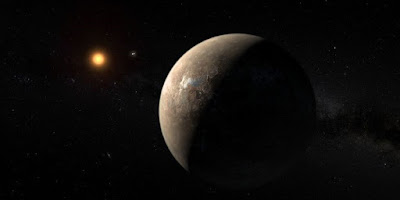 |
| Kepler Telescope |
Nine of those planets in particular are similar in size to Earth, and they are in the habitable zone, close enough to their parent star for liquid water to exist on their surfaces, but not so close that it will boil away.
Life could exist on any or all of them. And the closest habitable planet among them may only be 11 light-years away.
Of course, the chance of a nearby civilisation being detectable from Earth is still extremely small, and would rely on the civilisation being at a similar level of development to our own. If it's less developed there would be no electronic emissions to detect,and no industrial processes that would leave the the signature of pollution. And if it is far advanced then its means of communication and travel could well be unrecognisable, and its home planet's atmosphere long since cleansed of the damaging activity of earlier times.
The only sure way to detect such civilisations would be to get close enough to observe them directly. If and when we do eventually have missions to other star systems I think the most likely evidence we are to find of an extra-terrestrial civilisation will be the artifacts and ruins of a species long extinct (and we are well on the way to becoming such 'evidence' if we continue to abuse our planet in the way we've been doing and if we continue to procrastinate about building off-world colonies).
I mentioned above that the closest habitable planet discovered by the Kepler Telescope may only be 11 light-years away, but there may be one even closer.
In early 2016 it was confirmed that an Earth-sized planet is orbiting Proxima Centauri, just 4.2 light-years from our Solar System. Called Proxima b, the planet is in the habitable zone where liquid water could exist in a stable form on the surface.
 |
| Proxima b |
This is remarkable news, especially as it happens to orbit the closest star to our sun. If such a planet just happens to exist so close then the liklihood of others in nearby star systems rises quite considerably.
A new project, known as Breakthrough Starshot, was announced in 2016 with the aim of proving that a fleet of light sail spacecraft, powered by Earth-based lasers, could make the journey to the Alpha Centauri system, including a flyby of the potentially habitable planet Proxima b, in 25 to 30 years. With a potential launch date of 2036, and with the now active support of NASA, it is possible some of those reading this now would be able to see the results of such a mission.
 |
| Solar-sail spacecraft powered by lasers from Earth |
There are issues with an Earth-like world orbiting a star like Proxima Centauri, though. The star is a red dwarf, not much larger than Jupiter, which means the planet needs to orbit very close to be in the habitable zone. In this case it is close enough that it completes its orbit, or year, in just over 11 days. Planets this close to their parent star are likely tidally locked, which means the same hemisphere always faces the star. This results in one hemisphere of the planet scorched in permanent sunlight, while the other is frozen in permanent night.
There is still hope for such a world. If the atmosphere is thick enough it should distribute some of the heat of the daylight side. And if there are significant oceans they will moderate the temperature further. Such a tidally locked world may well be quite habitable for humans, at least on the terminator (the border between day and night).
 |
| A tidally locked planet, with a scorched desert on its star-facing side, and a frozen wasteland on the dark side. Only the land at the terminator of such planets may be habitable. |
I find exo-planet research to be the most exciting area of astronomy. As the technology and techniques to perform it improve year on year we will, sooner rather than later, make some quite revelationary discoveries, including evidence of life on a world far removed from our own.
How amazing that is going to be is hard to describe.

No comments:
Post a Comment